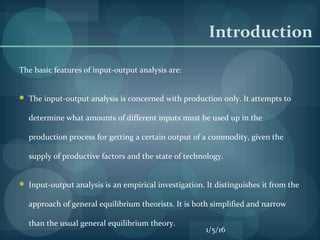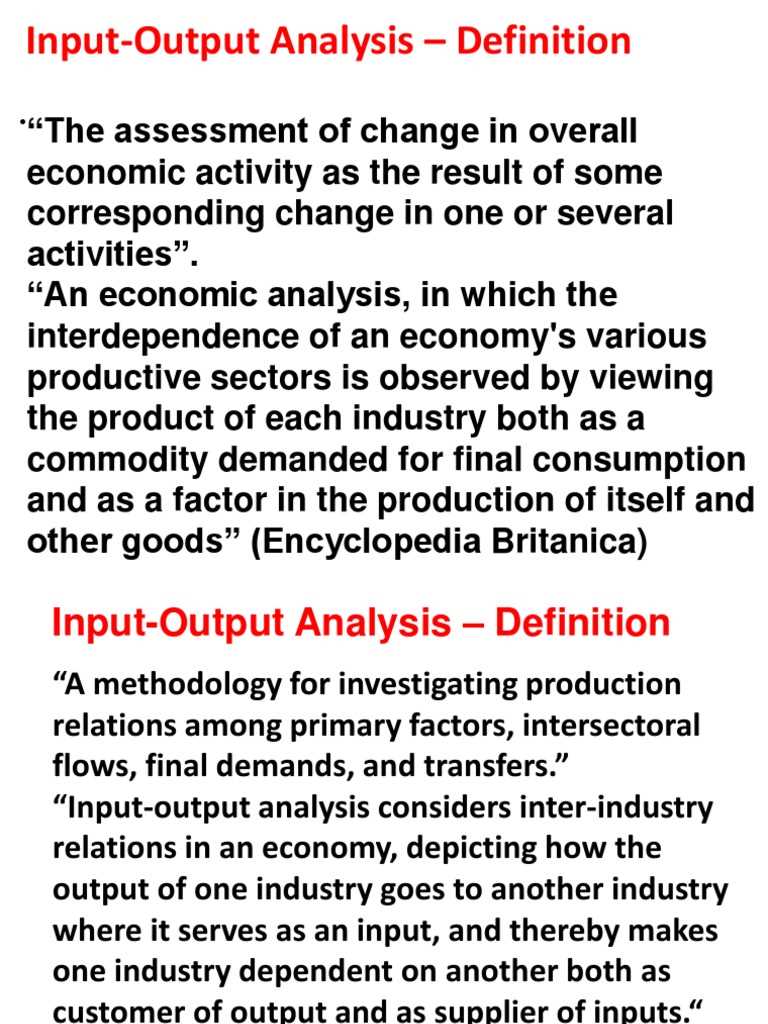Input-Output Analysis: Definition and Features
The main feature of Input-Output Analysis is its focus on the flow of goods and services between sectors. It examines the inputs required by each sector and the outputs produced by each sector, and how these inputs and outputs are interconnected. This analysis helps to identify the linkages and dependencies between sectors, and how changes in one sector can have ripple effects throughout the economy.
One key aspect of Input-Output Analysis is the use of input-output tables, which provide a detailed breakdown of the inputs required and outputs produced by each sector. These tables show the interrelationships between sectors and provide a comprehensive picture of the economy’s structure.
Furthermore, Input-Output Analysis can be used to model the effects of policy changes or external shocks on the economy. By simulating different scenarios, policymakers can assess the potential impacts of their decisions and make informed choices.
The basic concept of input-output analysis is that every industry or sector in an economy requires inputs from other sectors to produce its output. These inputs can be in the form of raw materials, intermediate goods, or services. At the same time, each sector also provides outputs to other sectors, which are used as inputs in their production processes.
The main objective of input-output analysis is to quantify these interdependencies and understand the flow of goods and services between sectors. This is done by constructing an input-output table, which shows the inputs required by each sector and the outputs produced by each sector. The table also includes information on the value of these inputs and outputs.
By analyzing the input-output table, economists can identify the key sectors in an economy and assess their contribution to overall economic activity. They can also analyze the effects of changes in one sector on other sectors and the economy as a whole. For example, if there is an increase in demand for a particular sector’s output, input-output analysis can help determine the sectors that will benefit from this increased demand.
Input-output analysis is also used to measure the economic impact of various policies and events. For example, it can be used to assess the effects of government spending on different sectors or the impact of a natural disaster on the economy.
| Benefits of Input-Output Analysis |
|---|
| 1. Identifies key sectors in the economy |
| 2. Assesses the impact of changes in one sector on other sectors |
| 3. Measures the economic impact of policies and events |
| 4. Provides a comprehensive picture of the interdependencies within an economy |
Key Features of Input-Output Analysis
Input-Output Analysis is a powerful tool used in macroeconomics to understand the interdependencies and relationships between different sectors of an economy. It provides valuable insights into the structure and functioning of an economy, helping policymakers and researchers make informed decisions.
1. Intersectoral Relationships

2. Circular Flow of Income

3. Multiplier Effect

The concept of the multiplier effect is another important feature of input-output analysis. It demonstrates how a change in final demand for a particular sector can lead to changes in output, income, and employment across multiple sectors. This multiplier effect helps in estimating the overall impact of policy interventions or changes in consumer behavior on the economy as a whole.
4. Input-Output Tables
Input-output analysis relies on the use of input-output tables, which provide a comprehensive framework for analyzing the relationships between sectors. These tables show the flows of goods, services, and payments between sectors, allowing for a detailed examination of the production and consumption patterns in the economy.
5. Quantitative Analysis
Input-output analysis is a quantitative approach that allows for the measurement and analysis of various economic variables. It provides a systematic framework for quantifying the interdependencies between sectors, making it easier to assess the impact of policy changes or shocks on the overall economy.
Types of Input-Output Analysis
Input-Output Analysis is a powerful tool used in macroeconomics to understand the interdependencies between different sectors of an economy. There are several types of Input-Output Analysis that can be used to analyze different aspects of an economy.
1. Direct Requirements Analysis
2. Indirect Requirements Analysis

Indirect Requirements Analysis takes into account the indirect relationships between industries. It looks at how changes in the demand for a particular industry’s output affect the demand for inputs from industries that supply intermediate goods and services to that industry. This type of analysis helps to identify the ripple effects of changes in demand throughout the economy.
3. Total Requirements Analysis
4. Multiplier Analysis
Multiplier Analysis measures the total impact of changes in demand on an economy. It takes into account not only the direct and indirect effects but also the induced effects, which are the changes in household consumption resulting from changes in income. This type of analysis helps to quantify the overall economic impact of changes in demand.
5. Sensitivity Analysis
Sensitivity Analysis examines the sensitivity of the input-output model to changes in key parameters, such as demand or technology. It helps to assess the robustness of the analysis and identify the key drivers of economic outcomes. This type of analysis is useful for scenario planning and policy analysis.
| Type | Description |
|---|---|
| Direct Requirements Analysis | Examines direct relationships between industries |
| Indirect Requirements Analysis | Examines indirect relationships between industries |
| Total Requirements Analysis | Combines direct and indirect relationships |
| Multiplier Analysis | Measures the total impact of changes in demand |
| Sensitivity Analysis | Examines the sensitivity of the model to changes in parameters |
Overall, the different types of Input-Output Analysis provide valuable insights into the structure and dynamics of an economy. They help policymakers, researchers, and businesses make informed decisions and understand the potential consequences of changes in demand and other economic factors.

Emily Bibb simplifies finance through bestselling books and articles, bridging complex concepts for everyday understanding. Engaging audiences via social media, she shares insights for financial success. Active in seminars and philanthropy, Bibb aims to create a more financially informed society, driven by her passion for empowering others.
